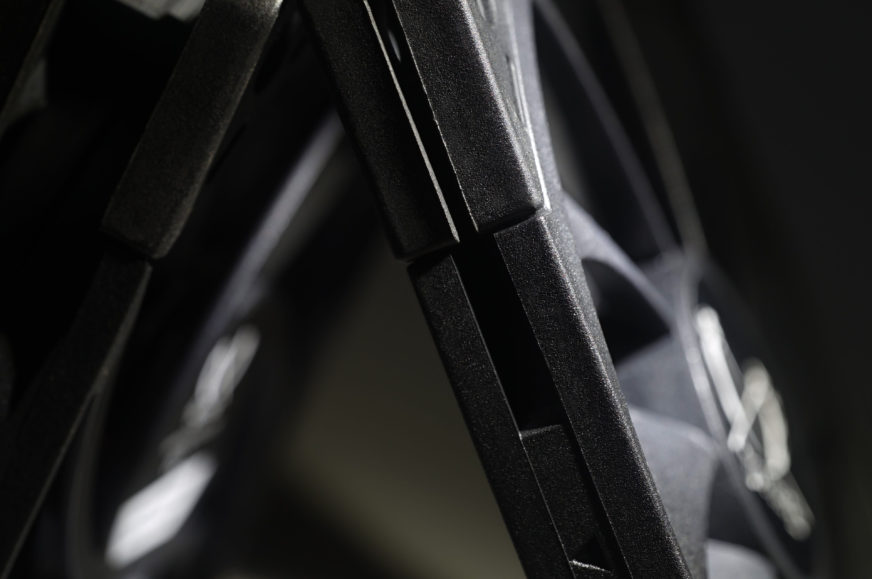Evaluation
Low-profile fans are a special category, but sometimes they are unavoidable in more confined spaces. For technical reasons, it’s always about compromises compared to more respectable fans of normal thickness, but their weight can vary. If the Arctic P12 Slim and Alphacool SL-15 don’t fit your needs, the Scythe Kaze Flex II 120 Slim may be the closest thing to what you’re looking for.
Evaluation
In the real world, the Kaze Flex II 120 Slim delivers quite impressive results for its format, which, when optimally set up, don’t slip into significant difficulties in any of the aspects under review.
Compared to the Arctic P12 Slim PWM PST, the Scythe fan is always weaker in the context of the airflow achieved, but without prominent tonal peaks. These do not appear with the Kaze Flex II 120 Slim at lower speeds (below 900 rpm) and are less pronounced when compared to the Alphacool SL-15 PWM fan. The latter, moreover, cannot even be slowed down to low speeds. Here (compared to the SL-15 PWM) the Kaze Flex II 120 Slim has the upper hand in terms of performance as well. On obstacles where the Scythe benefits from slightly higher static pressure, the Kaze Flex II 120 Slim’s airflow, for example through a radiator, is usually more intense.
The Alphacool (SL-15 PWM) has a slight edge in non-restrictive environments, where the advantage of the larger span of the eleven blades becomes apparent. In common practice, however, across applications, the Kaze Flex II 120 Slim usually pulls ahead and at the same time with higher power efficiency – the Scythe fan has a lower power draw per unit of airflow. Meanwhile, the Kaze Flex II 120 Slim motor is already well oversized compared to the Arctic P12 Slim PWM PST, even with a margin that can be utilized in conditions of very high environmental resistance or, over time, natural wear and tear, when internal friction (and with it, motor power requirements) will increase.
The fact that the Scythe fan is from a slightly different quality class is evidenced by the super low vibration as well. These are, of course, mainly due to the short blades, which do not generate excessive vibrations. But it is also a certain indication of precision when it comes to details such as rotor centering or the accuracy of the injection moulds.
The weaknesses of the Kaze Flex II 120 Slim start to appear at medium (from 950 rpm) and higher speeds, where there are already some tonal peaks.. On obstacles they are mainly created by resonant frequencies from the air flowing around them (through the obstacles), where for example, on a plastic filter there are noisier “humming” frequencies around 390 Hz and on a grille then even higher, at 480 Hz. And then there are also some lower, rumblier frequencies between 180–200 Hz. But all of this is only at higher speeds, for which this fan is not well suited anyway.
Scythe’s low-profile fan is attractive, as mentioned above, especially at lower speeds, which can be reduced via PWM down to around 300 rpm. The Kaze Flex II 120 Slim does not suffer from annoying motor noises or disturbing bearing noises. This means that it is especially a very good choice for small computers tuned to run as quietly as possible. How far Scythe has gone in this direction will probably become apparent only after a direct confrontation of the results with the Noctua NF-A12x15 PWM.
The price/performance ratio is slightly below average considering all the fans (thick, 25mm ones and 140mm ones), which also puts the Kaze Flex II 120 Slim in a good light. Sure, the P12 Slim PWM PST is on a different level in this, but with it, Arctic is betting it all on this one card. With the Kaze Flex II 120 Slim, Scythe also paid special attention to the acoustic profile or the higher structural sturdiness of the design as such. It’s just a shame that it can collide with some dust filters (typically nylon filters without a reinforced mesh). Otherwise, those design flaws of the Kaze Flex II 120 Slim are minimal.
English translation and edit by Jozef Dudáš
| Scythe Kaze Flex II 120 Slim |
| + Suitable for every use case |
| + Decent price/cooling performance ratio |
| + Extra compatibility due to the lowered profile |
| + Higher efficiency than weaker fans with a thicker profile |
| + Particularly attractive operation at lower speeds below 900 rpm... |
| + ... where the fan is more acoustically pleasing than selected competitive solutions |
| + Very quiet operation of bearings and motor |
| + Super low, negligible vibration |
| + Given the format, an extremely sturdy build |
| + Wide speed range |
| + Low speeds possible, stable via PWM down to approx. 309 rpm |
| - At medium and higher speeds, tonal peaks at lower sound frequencies (around 190 Hz)... |
| - ... and with obstacles also at higher sound frequencies between (380–500 Hz) |
| - Eventual collision with nylon dust filters |
| - No support for passive operation at low PWM duty cycle |
| Approximate retail price: 17 EUR |
- Contents
- Scythe Kaze Flex II 120 Slim in detail
- Overview of manufacturer specifications
- Basis of the methodology, the wind tunnel
- Mounting and vibration measurement
- Initial warm-up and speed recording
- Base 6 equal noise levels…
- ... and sound color (frequency characteristic)
- Static pressure measurement…
- … and airflow
- Everything changes with obstacles
- How we measure power draw and motor power
- Measuring the intensity (and power draw) of lighting
- Results: Speed
- Results: Airlow w/o obstacles
- Results: Airflow through a nylon filter
- Results: Airflow through a plastic filter
- Results: Airflow through a hexagonal grille
- Results: Airflow through a thinner radiator
- Results: Airflow through a thicker radiator
- Results: Static pressure w/o obstacles
- Results: Static pressure through a nylon filter
- Results: Static pressure through a plastic filter
- Results: Static pressure through a hexagonal grille
- Results: Static pressure through a thinner radiator
- Results: Static pressure through a thicker radiator
- Results: Static pressure, efficiency by orientation
- Reality vs. specifications
- Results: Frequency response of sound w/o obstacles
- Results: Frequency response of sound with a dust filter
- Results: Frequency response of sound with a hexagonal grill
- Results: Frequency response of sound with a radiator
- Results: Vibration, in total (3D vector length)
- Results: Vibration, X-axis
- Results: Vibration, Y-axis
- Results: Vibration, Z-axis
- Results: Power draw (and motor power)
- Results: Cooling performance per watt, airflow
- Results: Cooling performance per watt, static pressure
- Airflow per euro
- Static pressure per euro
- Results: Lighting – LED luminance and power draw
- Results: LED to motor power draw ratio
- Evaluation













On the evaluation page, the link to frequency analysis on plastic filters was wrong (39 instead of 29). Also, the summary was wrongly replaced by the spec table.
On your evaluation of frequency, you say thay the weakness of the fan only shows when it runs above 1100 RPM (that is 45 dBA). But from reading the charts, there seems to be strong peaks that appear in 39 dBA mode (959 RPM) as well. Did I interpret the data incorrectly?
Thank you for the heads up. Corrected. Including the charts that were really messed up. I was already in advanced stages of exhaustion when I released it yesterday…
… you read the spectrographs well. Yes, you are right, even the 39 dBA (~959 rpm) mode is characterized by more pronounced tonal peaks, so I’ve modified that statement a bit. Below 850 rpm it’s fine in that respect. Approximately such speeds at 39 dBA correspond to tests with a plastic filter and on a grille, which increase the noise level, so when tuned to the same level the fan speeds will always be a bit slower than in a use case without an obstacle.
So thanks for this observation and apologies for the inaccurate interpretation of the results. I wrote the article a bit under pressure and at the same time on the verge of complete exhaustion. I hope that similar mistakes will be avoided in the future.
You don’t have to apologize, it does not take away from the fact that the overall analysis is great work.
Health is very important. I hope you’ll find time to take a good rest and don’t push yourself too hard 🙂. Take care.
Guys, please test 120 and 140x25mm Kaze Flex – they were highly praised by other (but not as advanced as you) reviewiers, especially as case fans. I generally really like them from my own experience for being solid performers; sounding well; having quiet motor and bearing and representing nice quality additionally proven by few years of using them in my own pc.
Sure, the 120 and 140 mm Kaze Flex II will be next in line as far as Scythe fans are concerned. I mean, maybe the Grand Tornado model, which is close to release, will fit in between them.